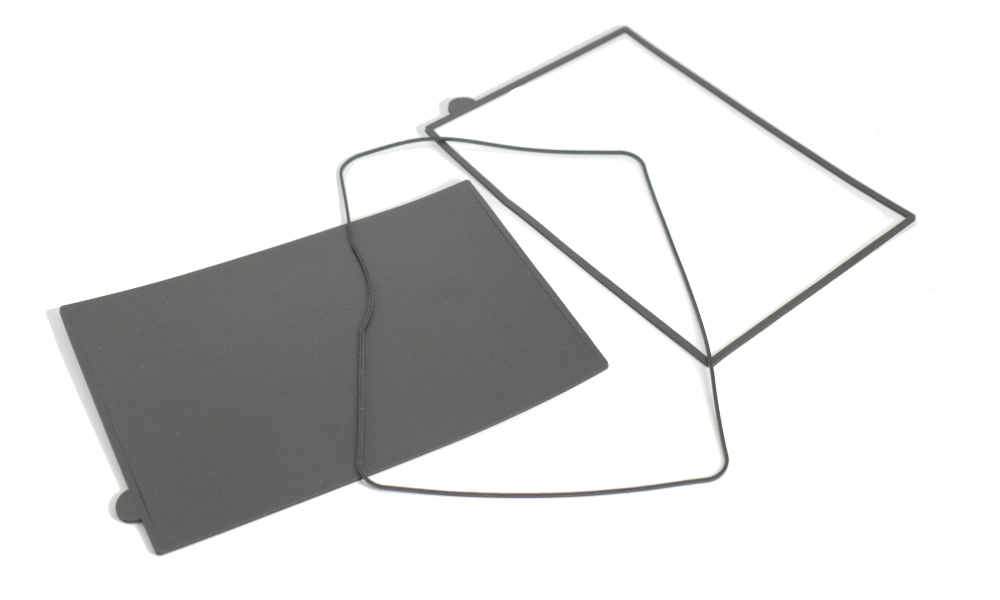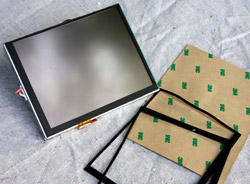Custom Gaskets
Touch Screen Gaskets
Using soft, conformal cellular materials for applications in cushioning, weather sealing, shielding (optional)
Using soft, conformal cellular materials for applications in cushioning, weather sealing, shielding (optional)

 Below are some guidelines for touch screen gaskets, LED and LCD display gaskets.
Below are some guidelines for touch screen gaskets, LED and LCD display gaskets.
The obvious location is to seal the enclosure at the edge of the viewing area of the enclosure. The sealing function can be for simple dust sealing, light water exposure such as occasional water drips or cleaning or even more aggressive outdoor applications where there is heavy water exposure.
Often a touch screen gasket or display gasket will help spread the compression load of the housing or bezel on the display. Without a gasket, the enclosure that holds the display in place can create pressure points on the display. In some cases, these pressures can cause distortions, false contacts or short circuits.
Similar to load distributing, touch panel gaskets are used to fill gaps between the screen and the display and/or the screen and bezel. The display gasket will take up gaps generated by tolerance stack-ups in the device.
Display gaskets offer some degree of cushioning to protect the display from damage due to mechanical shock. In the event that a device is dropped or banged, the gasket will act as a touchscreen cushion, offering a limited amount of protection.
Touchscreen gaskets also serve as display cushions when a user presses on the display too hard. The gasket deflects, takes up and spreads the load offering some protection from over-press or overloading in a small area.
LCD dust seals and touch screen dust seals are the most basic requirement of display gasketing. These are often static (not portable), indoor applications where the device is not to be exposed to water. Sealing can be achieved by closed cell sponge materials or fine pore open cell materials such as PORON urethane foam.
Materials for consideration: PORON 4701-30, PORON 4790-92
Portable electronics or touchscreens used by the public such as gaming touchscreens or indoor information kiosks inevitably will be exposed to some water. This can come from cleaning and beverage splashing, or for portable devices – rain. These electronic devices are also more likely to be exposed to mechanical shocks, such as banging or dropping. Closed cell or compressed microcellular foam materials will offer more protection against incidental, light water exposure.
Materials for consideration: HT-800, PORON 4701-41, other PORON grades with proper compression, Neoprene sponge
Outdoor displays such as outdoor information kiosks, ATMs and remote monitoring equipment require more design consideration. To contend with environments such as direct or wind-driven rain, sealing an enclosure, case or housing from ingress requires the proper material as well as proper compression on the gasket. Silicone foam or silicone sponge materials are preferred. Silicone gaskets remain flexible at low temperatures allowing for continued sealing against melting ice and snow as well as protecting against mechanical shock where many other materials will firm up in the cold and transfer energy. Other key features are: closed cell structure, low-stress relaxation, UV and ozone resistance, and general long life.
Materials for consideration: HT-800, R10470M, R10480S, EPDM sponge
Ruggedized electronics typically need to withstand much more aggressive environments. This may include passing rain or wash down tests such as IP65, IP66 and possibly IP67. Beyond sealing, they often need to survive the cold soak drop test, tumbling, EMI susceptibility, and a variety of other tests depending on usage. View more information on ruggedizing electronics.
Light leaking is sometimes a concern with certain LCD or LED display applications. This can be addressed with black gasketing with either a very thin adhesive or a black supported adhesive. A common material configuration for this is soft PORON urethane foam with 3M 9795B adhesive. The 3M 9795B is a film supported double coat adhesive with a black PET support layer that does not pipe light.
Touchscreen gaskets and display gaskets tend to have narrow walls that don’t always lend themselves to easy installation. This can be addressed in a few ways such as fixturing or utilizing the centers as temporary supports. The preferred adhesives for touchscreen gaskets and display gaskets are repositionable adhesives such as Adchem 8311M or 3M 9415 depending on the bond strength required. Stockwell Elastomerics also offers medium and high bond strength adhesives for permanent bonding. View the current listing of pressure sensitive adhesive options.
Most touch panel or touch screen manufacturers offer guidelines for gasketing. These typically show the active screen area, viewing area, and the gasket area. The manufacturer offers various recommendations on adhesive strength and gasket material type, but caution should be taken since each application will vary.
Broad recommendations such as “closed cell foam” do not take into consideration factors such as stress relaxation, compression set, long term sealing performance, outgassing, plasticizer interaction, cost, and manufacturability. Over-designing the gasket can drive the cost up, whereas under designing could result in damaged devices and leaks when the units are in the field. Stockwell Elastomerics can offer guidance on design and manufacturability of touchscreen gaskets or touch panel gaskets. Key design points include:
Common sealing conditions include:
The interior opening of the gasket should follow the touch screen manufacturer’s recommendation that stays clear of the active area. The outer dimension are defined by the available space behind the bezel or in the case. A rough rule of thumb is that the gasket wall should be 1.5x the thickness. (Example: .062″ thick gasket should have a gasket with .093″ or greater flange width.) This allows for die cutting and makes for a stable gasket when installed. A gasket that is taller than it is wide tends to fold over during compression. The exception to this is when the gasket is captive in a groove.
It is important to keep in mind the clamping loads. While wider gasket walls generally seal better, the overall surface area is directly related to the loads applied to the LCD and touchscreen. Compression Force Deflection curves of various materials are available to aid designers.
Some housing designs allow the touch panel gasket to wrap around the sides to make a tighter fit in the housing. Wrapping the gasket also gives the touch panel assembly additional cushioning for mechanical shock.
Proper compression of the gasket is critical to sealing. A rigid bezel or frame is required to prevent bowing between fasteners. Softer materials can help offset this however there are some limitations. Closed cell gasket materials help prevent wicking through the material but may not be soft enough. Soft open cell materials can be used but require more than 50% deflection (.062″ thick deflected to .031″ thick) in order to close the cell openings.
The gasket thickness will depend on the designed gap in the enclosure, the fastening scheme, rigidity of the housing and the level of sealing required. Many touch screen gaskets are thin and soft but as the display gets larger the tolerance stacks typically get larger as well. This may require a thicker gasket depending on the fastener locations.
PORON microcellular urethane foams are designed for electronic applications, therefore there are many standards, off-the-shelf thickness and firmness options available. Further, PORON is cast to an accurate thickness tolerance. PORON in thickness of .062″ and greater is cast to ± 10%. This is a very tight tolerance for a cellular gasketing material.
Designing the touch panel gasket for manufacturability can keep costs down – both part cost and touch panel assembling cost. For mid- and high-volume quantities, die cutting is the preferred method. A steel rule die can be produced quickly and inexpensively to allow the gasket to be kiss-cut against the adhesive release liner. Kiss-cutting allows the gasket installer to peel the gasket from a roll. Kiss-cut parts drastically improve throughput during assembly as compared to individually removing a liner from a loose part.
Some OEMs and contract manufacturers prefer to have the center of the gasket remain in place, held in place with small, breakaway tabs. Leaving the centers intact allows for easier positioning on the display when a fixture is not being used. Low tack, clean peeling adhesive is needed.
Specification requirements help with material selection, for example, NEMA 4, IP 65 or IP 66 will require closed cell or solid materials in order to pass testing. Less aggressive requirements such as NEMA 12 and IP 54 allow for more material options.
Typical UL specifications are UL 94, UL 508 (UL 60947) and UL 50. UL 94 addresses a flame requirement, UL 508 (UL 60947) is suitability for industrial controls, and UL 50 and UL 50E are for gasketing. Other UL specifications may apply depending on how and where the end product is being used.
Contact Us for further assistance with gaskets for touch screens, touch panels, LEDs and LCDs.